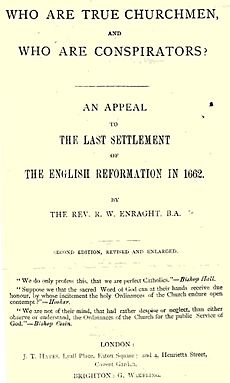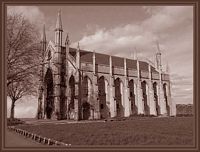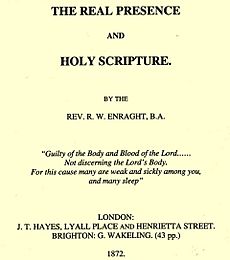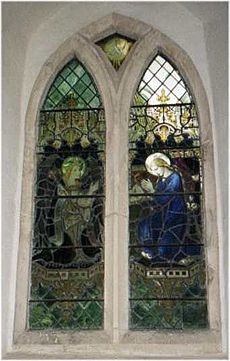Richard Enraght facts for kids
Quick facts for kids Richard William Enraght |
|
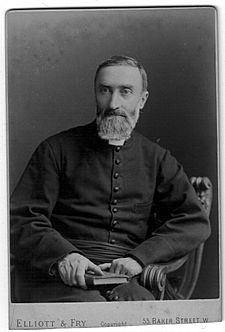 |
|
| Born | 23 February 1837 in Moneymore, County Londonderry, Ireland |
|---|---|
| Died | 21 September 1898 in Bintree, Norfolk, England |
| Church | Church of England |
| Ordained |
|
| Spouse | Dorothea |
| Children | 7 |
Richard William Enraght (23 February 1837 – 21 September 1898) was an Irish priest in the Church of England during the late 1800s. He was part of a movement called the Oxford Movement. This group believed in bringing back older, more traditional ways of worship to the Church of England.
Enraght thought that using special ceremonies and rituals in church services was very important. He believed these traditions helped the Church of England stay true to its ancient Christian roots. However, his religious practices and writings about worship led to disagreements with church leaders. He was even taken to court under a law called the Public Worship Regulation Act.
Some of the practices Enraght used included showing great respect for the Blessed Sacrament (the bread and wine used in Holy Communion), using candles during services, and wearing special robes like the chasuble and alb. He also used wafer bread for Communion and mixed water with the wine. He would make the sign of the Cross towards the people and bow his head during certain prayers. His bishop had forbidden these actions. Because of this, lawyers from a group called the Church Association took him to court.
Enraght refused to go to his own trial because he felt the court did not have the right to judge spiritual matters. He was found guilty and faced the harshest punishment under the law: arrest, imprisonment, and being removed from his church job. This attempt to stop traditional worship actually made many people support the priests who were punished. It made the law seem unfair and outdated. Later, the city of Brighton & Hove honored Enraght as a "Priest, fighter for religious freedom."
Contents
Becoming a Priest
Early Life and Studies
Richard Enraght was born in Moneymore, Ireland, on February 23, 1837. Not much is known about his early childhood. In 1860, when he was 23, he earned a Bachelor of Arts degree from Trinity College Dublin. The next year, he became a Deacon (the first step to becoming a priest) at Gloucester Cathedral. In 1862, he became a full priest. He worked as a Curate (an assistant priest) at St Bartholomew Church in Corsham, England.
Starting His Ministry
After three years in Corsham, Enraght moved to Sheffield in 1864. There, he showed how dedicated he was to the Anglo-Catholic movement. He wrote pamphlets (small booklets) criticizing the "pew-rent system." This system made poor people unable to attend church because they couldn't afford to pay for a seat. He also wrote about "Bible-Ritualism", which was his way of saying that relying only on the Bible for worship rules was not enough. In 1866, he moved to Wrawby, Brigg, for a year. Then, in 1867, Enraght went to Brighton to work as a curate for Arthur Wagner. Wagner was a very important leader in the traditional Catholic Revival in Brighton.
His Work in Brighton and Beyond
Brighton's Special Religious Style
The Anglican Church in Brighton was strongly influenced by the Oxford Movement. This was more true in Brighton than almost anywhere else in England, except London. People even joked about a "London-Brighton and South Coast Religion." This was a play on the name of a railway company, the "London, Brighton and South Coast Railway." This railway connected many of the growing Anglo-Catholic churches from London to Brighton and along the coast.
Arthur Wagner, Enraght's vicar, was a key figure in Brighton's Catholic Revival. He spent his own money to build many churches and schools. He also built 400 houses for poor people. Wagner's church practices were even debated in the British Parliament. Some people wanted to pass laws to stop him from appointing other Anglo-Catholic priests to the churches he had funded.
Local newspapers and a group called the Brighton Protestant Defence Association were very against traditional priests. The Brighton Gazette newspaper often wrote harsh articles about clergy who followed the English Catholic Tradition. In 1873, the newspaper reported that Father Wagner refused to answer questions in court that would make him break the secret of the confessional. After this, Father Wagner was attacked on the streets of Brighton. His attackers went to prison, but Wagner, being very kind, supported their wives and families financially. Other priests in Brighton also faced violence for their beliefs.
Another priest in Brighton, Father John Purchas, was taken to court for wearing special vestments and standing in the "eastward position" during services. His trial lasted three years, and he also refused to attend. The Church of England ended up paying a lot of money in court costs.
While working with Father Wagner, Enraght wrote a pamphlet called "Who are True Churchmen and Who are Conspirators?". This booklet was shared all over the country. In it, he argued that the English Church was both Catholic and Reformed. He aimed his writing at the Church Association, trying to fight against their campaign targeting Anglo-Catholic priests. He explained that the Church of England's rules, set in 1662, were clearly Catholic. He said that Catholic-minded clergy were truly following the Church's teachings.
Enraght's essay received good reviews from several church publications.
Leading a Church in Portslade
In 1871, Father Richard William Enraght became the Priest in Charge of St Andrew Church in Portslade by Sea. This was his first time being fully responsible for a church. His appointment caused some debate, but he continued his work.
Portslade was only three miles from Brighton, with good train connections. This allowed Father Enraght to stay involved with the Brighton branch of the Society of the Holy Cross, a group that supported Anglo-Catholic practices. He also worked as a secretary for a national group that wanted to end "pew-rents." St Andrew Church in Portslade, built in 1864, was one of the first churches in Sussex that never charged for seats.
In Portslade, Enraght kept writing pamphlets and letters to The Brighton Gazette. He promoted the English Catholic Tradition within the Church of England. He published "Catholic Worship," which explained why rituals were important. He also wrote "The Real Presence and Holy Scripture," which was praised for explaining the meaning of the Eucharist (Holy Communion).
These writings put Enraght in conflict with The Brighton Gazette. This local newspaper supported the Public Worship Regulation Act and wanted to stop any traditional worship in local churches. The newspaper often accused Enraght of trying to make local schools too "Puseyite" (a negative term for Anglo-Catholics).
In 1874, the government passed the Public Worship Regulation Act. This law was meant to stop traditional worship in the Church of England. However, priests like Wagner, Purchas, and Enraght had many people who supported them. The local press continued its campaign to use the new law against traditional priests.
In late 1874, Father Enraght left Portslade. He took on a new challenge in Birmingham, becoming the Vicar of Holy Trinity, Bordesley. This area was also very active with the Church Association. Portslade had been a good step for Enraght, as it was his first church where he had full responsibility. Being close to Brighton, he could keep his connections with the Society of the Holy Cross and Father Wagner.
Birmingham and the Church Association
In 1874, Father Richard William Enraght became the vicar at Holy Trinity Church, Bordesley. The previous vicar also followed the Oxford Movement. Enraght was friends with two other priests in Birmingham, James and Thomas Pollock, who also celebrated Anglo-Catholic traditions. All three had studied at Trinity College Dublin.
Father Enraght was very popular. Between 400 and 500 people attended his Sunday morning Holy Communion services. Sunday evening services with a sermon often drew 700 to 800 people. With his church members' support, Enraght started having Holy Communion services during the week. He made the services more beautiful and showed great kindness. No one in his church complained about the services.
The Church Association, a group of Protestants with a lot of money, was very active in Birmingham. They wanted to stop traditional priests. They would find people in a church who would complain about the priest. These "aggrieved parishioners" could then start a legal case under the new law. In one case, the Association even offered a churchwarden £10,000 (a huge amount of money back then) to speak against his priest.
The Church Association was very aggressive. They aimed to "uphold the Principles and Order of the United Church of England and Ireland." They used legal action to fight traditional worship in many places. Even a bishop, William Connor Magee, called the Church Association the "Persecution Company Limited."
Facing Legal Challenges
Why He Was Prosecuted
Father Enraght's practices at Holy Trinity, Bordesley, included showing respect for the Blessed Sacrament, using candles, wearing special robes, and using wafer bread for Holy Communion. He also mixed water with the wine, made the sign of the Cross towards the people, and bowed his head during the Gloria. He also allowed the Agnus Dei to be sung. His bishop, Dr. Philpott, had told him not to do these things. Because he continued, he faced legal action from the Church Association's lawyers and Judge Lord Penzance.
Father Enraght argued that if the English Church was truly part of the one Catholic Church, then its buildings and services should look like those in other parts of the Catholic Church.
He refused to attend his trial on July 12, 1879. He explained that he could not accept Lord Penzance or his court as having any spiritual authority over him, since the court's power came only from an Act of Parliament, not from the Church itself. He was found guilty in his absence on August 9, 1879, on 16 charges of breaking the law.
Enraght's case became known across the country as the "Bordesley Wafer Case." This was because one of the key pieces of evidence was a consecrated wafer. On August 31, 1879, Enraght spoke out from the altar about someone who, on February 9, had pretended to take Communion but secretly took a consecrated wafer. This wafer was then used as evidence in court. People were shocked and angry about this act, which they saw as a terrible disrespect. The consecrated wafer was later recovered and given to the Archbishop of Canterbury, who respectfully consumed it.
His Time in Prison
On November 27, 1880, Father Enraght was arrested at his home and taken to Warwick Prison to serve his sentence.
When he arrived at the prison, he knelt on the damp stones, and a doctor gave him a solemn blessing. People who were there said that Enraght was calm and cheerful, even though his friends were very upset. The Governor of Warwick Prison, who was not a traditional churchman, said of Enraght, "The sooner that gentleman is out, sir, the better, for he is altogether in the wrong place."
Enraght was held in Warwick Prison for almost two months. During this time, a huge meeting was held in Birmingham Town Hall to protest his imprisonment. Many people came from far and wide to show their support.
The imprisonment of English priests for their religious practices gained international attention, especially in the United States. A priest in New York, Revd Dr. Ewer, gave a sermon about "The Imprisonment of English Priests for Conscience Sake." He said Enraght's stand was a strong resistance to breaking the "Magna Charta" (a famous document about rights). He felt proud to support them. His sermon was printed in major New York newspapers. Four other priests in England also went to prison under the same law.
In England, a respected scholar named Revd Prof. Edward Bouverie Pusey wrote a letter to The Times newspaper. He defended Enraght and another priest, saying they were fighting for their people, not for themselves. He said that traditional priests only wanted to be allowed to use rituals that no one had questioned just a few years before. Since Enraght was in prison over Christmas, he was happy to receive letters of support and Christmas cards from children in his church.
A Protest Poster from 1880
A protest poster was made in 1880 to support the imprisoned priests. A copy of this poster was even put up near Lambeth Palace, which was the home of Archbishop Tait, and it annoyed him greatly.
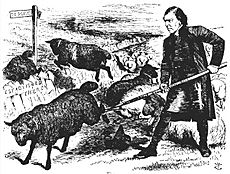
The poster compared the priests' imprisonment to historical events where people suffered for their beliefs:
- In ancient times, people like three Jews and Daniel were punished for their beliefs.
- In the early Christian era, John the Baptist, Our Blessed Lord, Peter, John, and Stephen suffered for their faith.
- During the 1500s, people like Hooper, Ridley, Latimer, and Cranmer were burned for their beliefs.
- In 1876, Arthur Tooth was imprisoned.
- In 1880, T. Pelham Dale and R.W. Enraght were in jail.
The poster ended with a powerful message: "By God’s Grace, may they light such a candle as shall never be put out."
Release from Prison
The English Church Union worked to get Father Enraght released. After 49 days in prison, he was set free because of a small mistake in the legal paperwork. The prosecutor tried to send him back to prison, but the English Church Union stopped it with their own legal actions.
Even though he was released, Father Enraght faced more trouble. In May 1882, he could have been sent back to prison. Three months later, church leaders declared his church job at Holy Trinity, Bordesley, empty, even though he still legally held it. In March 1883, Bishop Philpott took away Enraght's license to be a priest and appointed another clergyman to the church, against the wishes of the church members.
After Father Enraght was removed from his church and his family was forced to leave their home, the church members held a large meeting to say goodbye. They collected money and gave it to Father and Mrs. Enraght as a thank you.
When Bishop Philpott preached at Holy Trinity two months later, the churchwardens gave him a formal protest. They condemned Enraght's removal and said, "We, the truly aggrieved, have been left as sheep without a shepherd." They also noted that the new clergyman's changes had caused many people to stop attending church.
A special Royal Commission studied these issues in 1881 and released a report in 1883. This was a major turning point for the Church of England. It led to the end of efforts to stop traditional worship. The priests' actions of civil disobedience and their time in jail had embarrassed some church leaders and brought together different groups within the church. It became clear that continuing to fight against traditional worship would threaten the unity of the Church.
Later Life and What He Left Behind
After leaving Holy Trinity, Bordesley, Father Enraght worked for nine years in east London. He served at the Church of St Michael and All Angels, Bromley-by-Bow from 1884 to 1888 and St Gabriel Church Poplar from 1888 to 1895.
In 1895, he moved to his final church, St Swithun's Church Bintree, in a quiet country area of Norfolk. He finished his ministry and life there. Those who knew him remembered his kind and helpful life as a priest and friend. People who saw his arrest and imprisonment never forgot how serious and sad that event was.
Enraght died on September 21, 1898. He was buried in the churchyard at St Swithun's. His grave is marked as a "Confessor" – someone who suffered for their faith but did not die for it. Two windows in the church's Lady chapel, showing the Annunciation of Our Lady, are dedicated to Father Enraght. A statue of St. Swithun above the church porch also honors him, saying: "It is placed as a memorial to a great and good priest Richard William Enraght."
Throughout Father Enraght's ministry, his wife Dorothea was very active in church life. She supported him through his trials, imprisonment, and when their family was forced to leave their home. During these hard times, a fund from The Church Union helped support Father Enraght and his family.
Family Life
Richard and Dorothea Enraght had seven children:
- Mary (born and died in 1866)
- William (born 1868)
- Ellen (born 1870)
- Hawtrey (born 1871)
- Grace (born 1873)
- Dora (born 1875)
- Alice (born 1879)
In 1896, Father Enraght had the joy of seeing his son Hawtrey become a priest in Norfolk. After Father Richard Enraght's death, his wife Dorothea and daughter Grace moved to Walsingham. There, Grace married the Revd Edgar Reeves, the Vicar of Walsingham.
Father Hawtrey Enraght served as Vicar of St Helen's, Ranworth. An altar in that church was dedicated to his father. Later, he worked at St Margaret's, Lowestoft. For his long and dedicated service, Revd Hawtrey Enraght was given the honorary title of Canon in 1928.
In 1933, the Catholic Literature Association paid tribute to Father Richard Enraght and the four other priests who had been imprisoned. They said that these brave priests helped win the religious freedom and tolerance that exists today. They noted that the law under which these priests suffered is still technically on the books, but it is no longer used.
A modern book, the Oxford Dictionary of the Christian Church, says that the attempt to stop traditional worship "so discredited the Act (in fact it created Anglo-Catholic martyrs) that it led to its being regarded as virtually obsolete." The Public Worship Regulation Act of 1874 was finally removed from the law books in 1963.
In February 2006, a Brighton newspaper reported that the Brighton & Hove City Council had chosen Father Richard Enraght as a candidate for a blue plaque. This plaque would be placed on his former home in Portslade to honor him as a "Priest, fighter for religious freedom." In September 2006, a local bus company, Brighton & Hove, named one of their new buses after him.
His Published Writings
Father Enraght wrote many pamphlets and lectures during his ministry:
- A sermon about the right to freedom of public worship in "The Church of the People" (while a curate in Sheffield).
- Another sermon (while a curate in Sheffield).
- "Who are True Churchmen and Who are Conspirators?" (while a curate in Brighton).
- "Free and Open Churches and the Weekly Offertory" (1871) – a lecture about not charging for church seats (while a curate in Brighton).
- "Catholic Worship" (while Priest in Charge in Portslade).
- "The Real Presence and Holy Scripture" (while Priest in Charge in Portslade).
- A lecture on the "Present Unconstitutional Exercise of the Royal Supremacy in Matters Spiritual" (while at Holy Trinity Bordesley).
- "A Pastoral to the Faithful Worshipping at Holy Trinity, Bordesley" (1879).
- "The Ridsdale judgement on vestments: Was it an intentional miscarriage of justice?" (1880).
- "My Ordination Oaths and other Declarations: am I Keeping Them?" (1880).
- "An Aggrieved Parish, or The Minutes of the Easter vestries in the Parish of Holy Trinity, Birmingham" (1881).
- A statement given to the Archbishop of Canterbury (while at Holy Trinity Bordesley).


